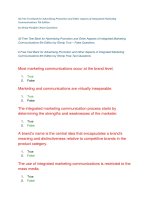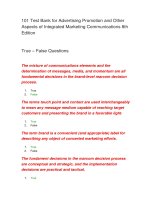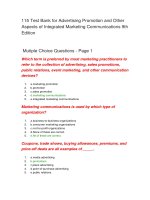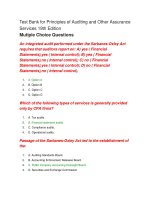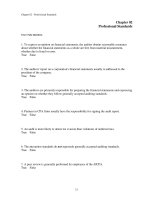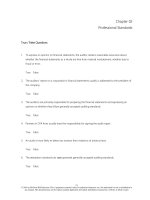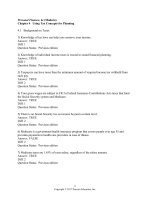Test bank principles of auditing and other assurance principles chapter 4 legal liabilities of CPAs
Bạn đang xem bản rút gọn của tài liệu. Xem và tải ngay bản đầy đủ của tài liệu tại đây (300.26 KB, 35 trang )
Chapter 04 - Legal Liability of CPAs
Chapter 04
Legal Liability of CPAs
True / False Questions
1. Fraud is defined as failure to use reasonable care in the performance of services.
True False
2. Most of the burden of affirmative proof is on the defendant under common law.
True False
3. The Ultramares v. Touche case held that auditors could be held liable to any foreseen third
party for ordinary negligence.
True False
4. The Securities Exchange Act of 1934 offers recourse against the auditors to a far greater
number of investors than does the Securities Act of 1933.
True False
5. The precedent set by the Hochfelder v. Ernst case is generally believed to have increased
auditors' legal liability.
True False
6. The auditors can be held liable for negligence in audits of financial statements, but not in
reviews of financial statements.
True False
4-1
Chapter 04 - Legal Liability of CPAs
7. The results of the Continental Vending Corporation case included the criminal prosecution
of auditors for gross negligence.
True False
8. Most charges made against auditors under common law are criminal.
True False
9. The Securities Act of 1934 includes provisions for criminal charges against persons
violating the Act.
True False
10. The use of engagement letters is generally designed to prevent lawsuits by third parties
against the auditors.
True False
Multiple Choice Questions
11. A CPA issued an unqualified opinion on the financial statements of a company that sold
common stock in a public offering subject to the Securities Act of 1933. Based on a
misstatement in the financial statements, the CPA is being sued by an investor who purchased
shares of this public offering. Which of the following represents a viable defense?
A. The investor has not proven CPA negligence.
B. The investor did not rely upon the financial statement.
C. The CPA detected the misstatement after the audit report date.
D. The misstatement is immaterial in the overall context of the financial statements.
4-2
Chapter 04 - Legal Liability of CPAs
12. Which of the following is a correct statement related to CPA legal liability under common
law?
A. CPAs are normally liable to their clients, the shareholders, for either ordinary or gross
negligence.
B. CPAs are liable for either ordinary or gross negligence to identified third parties for whose
benefit the audit was performed.
C. CPAs may escape all personal liability through incorporation as a limited liability
corporation.
D. CPAs are guilty until they prove that they performed the audit with "good faith."
13. Under Section 10 of the 1934 Securities Exchange Act auditors are liable to security
purchasers for:
A. Lack of due diligence.
B. Existence of scienter.
C. Ordinary negligence.
D. Auditors have no liability to security purchasers under this act.
14. Jones, CPA, is in court defending himself against a lawsuit filed under the 1933 Securities
Act. The charges have been filed by purchasers of securities covered under that act. If the
purchasers prove their required elements, in general Jones will have to prove that:
A. He is not guilty of gross negligence.
B. He performed the audit with good faith.
C. He performed the audit with due diligence.
D. The plaintiffs did not show him to be negligent.
15. An auditor knew that the purpose of her audit was to render reasonable assurance on
financial statements that were to be used for the application for a loan; the auditor did not
know the identity of the bank that would eventually give the loan. Under the Restatement of
Torts approach to liability the auditor is generally liable to the bank which subsequently
grants the loan for:
A. Lack of due diligence.
B. Lack of good faith.
C. Gross negligence, but not ordinary negligence.
D. Either ordinary or gross negligence.
4-3
Chapter 04 - Legal Liability of CPAs
16. An auditor knew that the purpose of her audit was to render reasonable assurance on
financial statements that were to be used for the application for a loan; the auditor did not
know the identity of the bank that would eventually give the loan. Under the foreseeable third
party approach the auditor is generally liable to the bank which subsequently grants the loan
for:
A. Lack of due diligence.
B. Lack of good faith.
C. Gross negligence, but not ordinary negligence.
D. Either ordinary or gross negligence.
17. Which of the following forms of organization is most likely to protect the personal assets
of any partner, or shareholder who has not been involved on an engagement resulting in
litigation?
A. Professional corporation.
B. Limited liability partnership.
C. Partnership.
D. Subchapter M Incorporation.
18. Under which common law approach are auditors most likely to be held liable for ordinary
negligence to a "reasonably foreseeable" third party?
A. Due Diligence Approach.
B. Ultramares Approach.
C. Restatement of Torts Approach.
D. Rosenblum Approach.
19. Assume that $500,000 in damages are awarded to a plaintiff, and the CPA's percentage of
responsibility established at 10%, while others are responsible for the other 90%. Assume the
others have no financial resources. As a result the CPA has been required to pay the entire
$500,000. The auditor's liability is most likely based upon which approach to assessing
liability?
A. Absolute liability
B. Contributory negligence
C. Joint and several liability.
D. Proportional liability.
4-4
Chapter 04 - Legal Liability of CPAs
20. Assume that $500,000 in damages are awarded to a plaintiff, and the CPA's percentage of
responsibility established at 10%, while others are responsible for the other 90%. Assume the
others have no financial resources. The CPA has been required to pay $50,000. The auditor's
liability is most likely based upon which approach to assessing liability?
A. Absolute liability.
B. Contributory negligence.
C. Joint and several liability.
D. Proportional liability.
21. Assume that a client has encountered a $500,000 fraud and that the CPA's percentage of
responsibility established at 10%, while the company itself was responsible for the other 90%.
Under which approach to liability is the CPA most likely to avoid liability entirely?
A. Absolute negligence.
B. Comparative negligence.
C. Contributory negligence.
D. Joint Negligence.
22. In which of the following court cases was a precedent set increasing liability to third
parties arising from audits under common law?
A. Rosenblum v. Adler.
B. Hochfelder v. Ernst.
C. 1136 Tenants Corporation v. Rothenberg.
D. Continental Vending.
23. The burden of proof that must be proven to recover losses from the auditors under the
Securities Exchange Act of 1934 is generally considered to be:
A. Less than the Securities Act of 1933.
B. The same as the Securities Act of 1933.
C. Greater than the Securities Act of 1933.
D. Indeterminate in relation to the Securities Act of 1933.
4-5
Chapter 04 - Legal Liability of CPAs
24. CPAs should not be liable to any party if they perform their services with:
A. Ordinary negligence.
B. Regulatory providence.
C. Due professional care.
D. Good faith.
25. The Second Restatement of the Law of Torts provides for auditor liability to a limited
class of foreseen third parties for:
A. Only criminal acts.
B. Either ordinary or gross negligence.
C. Only gross negligence.
D. Only fraud.
26. A principle that may reduce or entirely eliminate auditor liability to a client is:
A. Client constructive negligence.
B. Client contributory negligence.
C. Auditor ordinary negligence.
D. Auditor gross negligence.
27. Under the Securities Act of 1933 the burden of proof that the plaintiff sustained a loss
must be proven by the:
A. Plaintiff.
B. Defendant.
C. SEC.
D. Jury.
28. A case by a client against its CPA firm alleging negligence would be brought under:
A. The Securities Act of 1933.
B. The Securities Exchange Act of 1934.
C. The state blue sky laws.
D. Common law.
4-6
Chapter 04 - Legal Liability of CPAs
29. Assume that a CPA firm was negligent but not grossly negligent in the performance of an
engagement. Which of the following plaintiffs probably would not recover losses proximately
caused by the auditors' negligence?
A. A loss sustained by a client in a suit brought under common law.
B. A loss sustained by a lender not in privity of contract in a suit brought in a state court
which adheres to the Ultramares v. Touche precedent.
C. A loss sustained by initial purchasers of stock in a suit brought under the Securities Act of
1933.
D. A loss sustained by a bank named as a third-party beneficiary in the engagement letter in a
suit brought under common law.
30. Which of the following court cases highlighted the need for obtaining engagement letters
for professional services?
A. Ultramares v. Touche.
B. Rosenblum v. Adler.
C. Hochfelder v. Ernst.
D. 1136 Tenants Corporation v. Rothenberg.
31. In which type of court case is proving "due diligence" essential to the auditors' defense?
A. Court cases brought under the Securities Exchange Act of 1934.
B. Court cases brought by clients under common law.
C. Court cases brought by third parties under common law.
D. Court cases brought under the Securities Act of 1933.
32. Which common law approach leads to increased CPA liability to "foreseeable" third
parties for ordinary negligence?
A. Ultramares v. Touche.
B. Restatement of Torts.
C. Rule 10b-5.
D. Rosenblum v. Adler.
4-7
Chapter 04 - Legal Liability of CPAs
33. Which of the following is the best defense that a CPA can assert against common law
litigation by a stockholder claiming fraud based on an unqualified opinion on materially
misstated financial statements?
A. Lack of due diligence.
B. Lack of gross negligence.
C. Contributory negligence on the part of the client.
D. A disclaimer contained in the engagement letter.
34. Which of the following must be proven by the plaintiff in a case against a CPA under the
Section 11 liability provisions of the Securities Act of 1933?
A. The CPA knew of the misstatement.
B. The CPA was negligent.
C. Material misstatements were contained in the financial statements.
D. The unqualified opinion contained in the registration statement was relied upon by the
party suing the CPA.
35. A CPA issued a standard unqualified audit report on the financial statements of a client
that the CPA knew was in the process of obtaining a loan. In a suit by the bank issuing the
loan the CPA's best defense would be that the:
A. Audit complied with generally accepted auditing standards.
B. Client was aware of the misstatements.
C. Bank was not the CPA's client.
D. Bank's identity was known to the CPA prior to completion of the audit.
36. The Private Securities Litigation Reform Act of 1995 imposes proportionate liability on
the CPA who:
A. Unknowingly violates the 1934 Securities Exchange Act.
B. Knowingly or unknowingly violates the 1934 Securities Exchange Act.
C. Unknowingly violates the 1933 Securities Act.
D. Knowingly or unknowingly violates the 1933 Securities Act.
4-8
Chapter 04 - Legal Liability of CPAs
37. Which of the following is not correct relating to the Private Securities Litigation Reform
Act of 1995?
A. It provides certain small investors better recovery rights than it does large investors.
B. It retains joint and several liability in certain circumstances.
C. It makes recovery against CPAs more difficult under common law litigation.
D. It eliminates securities fraud as an offense under civil RICO.
38. A limited liability partnership form of organization:
A. Decreases liability of all partners of a CPA firm.
B. Has similar liability requirements to that of a professional corporation.
C. Eliminates personal liability for some, but not all, partners.
D. Eliminates personal liability for all partners.
39. Which of the following is accurate with respect to litigation involving CPAs?
A. A CPA will not be found liable for an audit unless the CPA has audited all affiliates of that
company.
B. A CPA may not successfully assert as a defense that the CPA had no motive to be part of a
fraud.
C. A CPA may be exposed to criminal as well as civil liability.
D. A CPA is primarily responsible, while the client is secondarily responsible for the notes in
an annual report filed with the SEC.
40. Starr Corp. approved a plan of merger with Silo Corp. One of the determining factors in
approving the merger was the strong financial statements of Silo which were audited by Cox
& Co., CPAs. Starr had engaged Cox to audit Silo's financial statements. While performing
the audit, Cox failed to discover certain instances of fraud which have subsequently caused
Starr to suffer substantial losses. In order for Cox to be liable under common law, Starr at a
minimum must prove that Cox:
A. Acted recklessly or with lack of reasonable grounds for belief.
B. Knew of the instances of fraud.
C. Failed to exercise due care.
D. Was grossly negligent.
4-9
Chapter 04 - Legal Liability of CPAs
41. Dexter and Co., CPAs, issued an unqualified opinion on the 20X3 financial statements of
Bart Corp. Late in 20X4, Bart determined that its treasurer had embezzled over $1,000,000.
Dexter was unaware of the embezzlement. Bart has decided to sue Dexter to recover the
$1,000,000. Bart's suit is based upon Dexter's failure to discover the missing money while
performing the audit. Which of the following is Dexter's best defense?
A. That the audit was performed in accordance with GAAS.
B. Dexter had no knowledge of the embezzlement.
C. The financial statements were presented in conformity with GAAP.
D. The treasurer was Bart's agent and as such had designed the controls which facilitated the
embezzlement.
42. Under common law, when performing an audit, a CPA:
A. Must exercise the level of care, skill, and judgment expected of a reasonably prudent CPA
under the circumstances.
B. Must strictly adhere to generally accepted accounting principles.
C. Is strictly liable for failures to discover client fraud.
D. Is not liable unless the CPA commits gross negligence or intentionally disregards generally
accepted auditing standards.
43. A CPA's duty of due care to a client most likely will be breached when a CPA:
A. Gives a client an oral report instead of a written report.
B. Gives a client incorrect advice based on an honest error of judgment.
C. Fails to give tax advice that saves the client money.
D. Fails to follow generally accepted auditing standards.
44. Under common law, which of the following statements most accurately reflects the
liability of a CPA who fraudulently gives an opinion on an audit of a client's financial
statements?
A. The CPA is liable only to third parties in privity of contract with the CPA.
B. The CPA is liable only to known users of the financial statements.
C. The CPA probably is liable to any person who suffered a loss as a result of the fraud.
D. The CPA probably is liable to the client even if the client was aware of the fraud and did
not rely on the opinion.
4-10
Chapter 04 - Legal Liability of CPAs
45. In a common law action against an accountant, lack of privity is a viable defense if the
plaintiff:
A. Is the client's creditor who sues the accountant for negligence.
B. Can prove the presence of gross negligence that amounts to a reckless disregard for the
truth.
C. Is the accountant's client.
D. Bases the action upon fraud.
46. If a CPA recklessly departs from the standards of due care when conducting an audit, the
CPA will be liable to third parties who are unknown to the CPA based on:
A. Ordinary negligence.
B. Gross negligence.
C. Strict liability.
D. Criminal deceit.
47. Hark, CPA, negligently failed to follow generally accepted auditing standards in auditing
Long Corporation's financial statements. Long's president told Hark that the audited financial
statements would be submitted to several, at this point undetermined, banks to obtain
financing. Relying on the statements, Third Bank gave Long a loan. Long defaulted on the
loan. In jurisdiction applying the Ultramares decision, if Third sues Hark, Hark will:
A. Win because there was no privity of contract between Hark and Third.
B. Lose because Hark knew that a bank would be relaying the financial statements.
C. Win because Third was contributory negligent in granting the loan.
D. Lose because Hark was negligent in performing the audit.
48. Under the Ultramares rule, to which of the following parties will an accountant be liable
for ordinary negligence?
A. Option A
B. Option B
C. Option C
D. Option D
4-11
Chapter 04 - Legal Liability of CPAs
49. Quincy bought Teal Corp. common stock in an offering registered under the Securities Act
of 1933. Worth & Co., CPAs, gave an unqualified opinion on Teal's financial statements that
were included in the registration statement filed with the SEC. Quincy sued Worth under the
provisions of the 1933 Act that deal with omission of facts required to be in the registration
statement. Quincy must prove that:
A. There was fraudulent activity by Worth.
B. There was a material misstatement in the financial statements.
C. Quincy relied on Worth's opinion.
D. Quincy was in privity with Worth.
50. Bran, CPA, audited Frank Corporation. The shareholders sued both Frank and Bran for
securities fraud under the Federal Securities Exchange Act of 1934. The court determined that
there was securities fraud and that Frank was 80% at fault and Bran was 20% at fault due to
her negligence in the audit. Both Frank and Bran are solvent and the damages were
determined to be $1 million. What is the maximum liability of Bran?
A. $0
B. $200,000
C. $500,000
D. $1,000,000
51. If a CPA recklessly departs from the standards of due care when conducting an audit, the
CPA will be liable to third parties who are unknown to the CPA based on
A. Negligence.
B. Gross negligence.
C. Strict liability.
D. Criminal deceit.
4-12
Chapter 04 - Legal Liability of CPAs
52. The Public Company Accounting Oversight Board may conduct investigations and
disciplinary proceedings of:
A. Option A
B. Option B
C. Option C
D. Option D
Essay Questions
53. Auditors may be held liable to both their clients and third parties under common law.
a. What must a client prove to recover its losses from the auditors under common law?
b. In a court that adheres to the precedent set by the Ultramares v. Touche case what must an
ordinary third party prove to recover losses from the auditors under common law?
54. A CPA firm has audited the financial statements included in a Form S-1 filed with the SEC
under the Securities Act of 1933. Shortly thereafter, the company went bankrupt and a class
action lawsuit was filed by the initial investors against the CPA firm.
a. What should the plaintiff investors attempt to prove?
b. Must the plaintiffs prove that they relied on the financial statements included in the Form
S-1?
c. What must the CPA firm prove in order to be successful with respect to the firm's defense?
4-13
Chapter 04 - Legal Liability of CPAs
55. A plaintiff may elect to bring a lawsuit against auditors under applicable statutes-including the Securities Act of 1933 and the Securities Exchange Act of 1934--and under
common law. For each circumstance, indicate the most likely source of CPA liability by
placing the appropriate letter in the third column.
a. The Securities Act of 1933
b. The Securities Exchange Act of 1934
c. Common Law
4-14
Chapter 04 - Legal Liability of CPAs
56. Section 11 of the Securities Act of 1933, and Section 10 of the Securities Exchange Act of
1934 make a CPA potentially liable to a purchaser of registered securities. For items a through
f, place a checkmark () under the column if the plaintiff must prove its existence:
4-15
Chapter 04 - Legal Liability of CPAs
Chapter 04 Legal Liability of CPAs Answer Key
True / False Questions
1. Fraud is defined as failure to use reasonable care in the performance of services.
FALSE
Difficulty: Easy
2. Most of the burden of affirmative proof is on the defendant under common law.
FALSE
Difficulty: Medium
3. The Ultramares v. Touche case held that auditors could be held liable to any foreseen third
party for ordinary negligence.
FALSE
Difficulty: Medium
4. The Securities Exchange Act of 1934 offers recourse against the auditors to a far greater
number of investors than does the Securities Act of 1933.
TRUE
Difficulty: Medium
5. The precedent set by the Hochfelder v. Ernst case is generally believed to have increased
auditors' legal liability.
FALSE
Difficulty: Hard
4-16
Chapter 04 - Legal Liability of CPAs
6. The auditors can be held liable for negligence in audits of financial statements, but not in
reviews of financial statements.
FALSE
Difficulty: Easy
7. The results of the Continental Vending Corporation case included the criminal prosecution
of auditors for gross negligence.
TRUE
Difficulty: Medium
8. Most charges made against auditors under common law are criminal.
FALSE
Difficulty: Medium
9. The Securities Act of 1934 includes provisions for criminal charges against persons
violating the Act.
TRUE
Difficulty: Medium
10. The use of engagement letters is generally designed to prevent lawsuits by third parties
against the auditors.
FALSE
Difficulty: Medium
4-17
Chapter 04 - Legal Liability of CPAs
Multiple Choice Questions
11. A CPA issued an unqualified opinion on the financial statements of a company that sold
common stock in a public offering subject to the Securities Act of 1933. Based on a
misstatement in the financial statements, the CPA is being sued by an investor who purchased
shares of this public offering. Which of the following represents a viable defense?
A. The investor has not proven CPA negligence.
B. The investor did not rely upon the financial statement.
C. The CPA detected the misstatement after the audit report date.
D. The misstatement is immaterial in the overall context of the financial statements.
Difficulty: Hard
12. Which of the following is a correct statement related to CPA legal liability under common
law?
A. CPAs are normally liable to their clients, the shareholders, for either ordinary or gross
negligence.
B. CPAs are liable for either ordinary or gross negligence to identified third parties for whose
benefit the audit was performed.
C. CPAs may escape all personal liability through incorporation as a limited liability
corporation.
D. CPAs are guilty until they prove that they performed the audit with "good faith."
Difficulty: Medium
13. Under Section 10 of the 1934 Securities Exchange Act auditors are liable to security
purchasers for:
A. Lack of due diligence.
B. Existence of scienter.
C. Ordinary negligence.
D. Auditors have no liability to security purchasers under this act.
Difficulty: Hard
4-18
Chapter 04 - Legal Liability of CPAs
14. Jones, CPA, is in court defending himself against a lawsuit filed under the 1933 Securities
Act. The charges have been filed by purchasers of securities covered under that act. If the
purchasers prove their required elements, in general Jones will have to prove that:
A. He is not guilty of gross negligence.
B. He performed the audit with good faith.
C. He performed the audit with due diligence.
D. The plaintiffs did not show him to be negligent.
Difficulty: Medium
15. An auditor knew that the purpose of her audit was to render reasonable assurance on
financial statements that were to be used for the application for a loan; the auditor did not
know the identity of the bank that would eventually give the loan. Under the Restatement of
Torts approach to liability the auditor is generally liable to the bank which subsequently
grants the loan for:
A. Lack of due diligence.
B. Lack of good faith.
C. Gross negligence, but not ordinary negligence.
D. Either ordinary or gross negligence.
Difficulty: Hard
16. An auditor knew that the purpose of her audit was to render reasonable assurance on
financial statements that were to be used for the application for a loan; the auditor did not
know the identity of the bank that would eventually give the loan. Under the foreseeable third
party approach the auditor is generally liable to the bank which subsequently grants the loan
for:
A. Lack of due diligence.
B. Lack of good faith.
C. Gross negligence, but not ordinary negligence.
D. Either ordinary or gross negligence.
Difficulty: Hard
4-19
Chapter 04 - Legal Liability of CPAs
17. Which of the following forms of organization is most likely to protect the personal assets
of any partner, or shareholder who has not been involved on an engagement resulting in
litigation?
A. Professional corporation.
B. Limited liability partnership.
C. Partnership.
D. Subchapter M Incorporation.
Difficulty: Medium
18. Under which common law approach are auditors most likely to be held liable for ordinary
negligence to a "reasonably foreseeable" third party?
A. Due Diligence Approach.
B. Ultramares Approach.
C. Restatement of Torts Approach.
D. Rosenblum Approach.
Difficulty: Medium
19. Assume that $500,000 in damages are awarded to a plaintiff, and the CPA's percentage of
responsibility established at 10%, while others are responsible for the other 90%. Assume the
others have no financial resources. As a result the CPA has been required to pay the entire
$500,000. The auditor's liability is most likely based upon which approach to assessing
liability?
A. Absolute liability
B. Contributory negligence
C. Joint and several liability.
D. Proportional liability.
Difficulty: Hard
4-20
Chapter 04 - Legal Liability of CPAs
20. Assume that $500,000 in damages are awarded to a plaintiff, and the CPA's percentage of
responsibility established at 10%, while others are responsible for the other 90%. Assume the
others have no financial resources. The CPA has been required to pay $50,000. The auditor's
liability is most likely based upon which approach to assessing liability?
A. Absolute liability.
B. Contributory negligence.
C. Joint and several liability.
D. Proportional liability.
Difficulty: Hard
21. Assume that a client has encountered a $500,000 fraud and that the CPA's percentage of
responsibility established at 10%, while the company itself was responsible for the other 90%.
Under which approach to liability is the CPA most likely to avoid liability entirely?
A. Absolute negligence.
B. Comparative negligence.
C. Contributory negligence.
D. Joint Negligence.
Difficulty: Hard
22. In which of the following court cases was a precedent set increasing liability to third
parties arising from audits under common law?
A. Rosenblum v. Adler.
B. Hochfelder v. Ernst.
C. 1136 Tenants Corporation v. Rothenberg.
D. Continental Vending.
Difficulty: Hard
4-21
Chapter 04 - Legal Liability of CPAs
23. The burden of proof that must be proven to recover losses from the auditors under the
Securities Exchange Act of 1934 is generally considered to be:
A. Less than the Securities Act of 1933.
B. The same as the Securities Act of 1933.
C. Greater than the Securities Act of 1933.
D. Indeterminate in relation to the Securities Act of 1933.
Difficulty: Medium
24. CPAs should not be liable to any party if they perform their services with:
A. Ordinary negligence.
B. Regulatory providence.
C. Due professional care.
D. Good faith.
Difficulty: Medium
25. The Second Restatement of the Law of Torts provides for auditor liability to a limited
class of foreseen third parties for:
A. Only criminal acts.
B. Either ordinary or gross negligence.
C. Only gross negligence.
D. Only fraud.
Difficulty: Medium
26. A principle that may reduce or entirely eliminate auditor liability to a client is:
A. Client constructive negligence.
B. Client contributory negligence.
C. Auditor ordinary negligence.
D. Auditor gross negligence.
Difficulty: Medium
4-22
Chapter 04 - Legal Liability of CPAs
27. Under the Securities Act of 1933 the burden of proof that the plaintiff sustained a loss
must be proven by the:
A. Plaintiff.
B. Defendant.
C. SEC.
D. Jury.
Difficulty: Medium
28. A case by a client against its CPA firm alleging negligence would be brought under:
A. The Securities Act of 1933.
B. The Securities Exchange Act of 1934.
C. The state blue sky laws.
D. Common law.
Difficulty: Medium
29. Assume that a CPA firm was negligent but not grossly negligent in the performance of an
engagement. Which of the following plaintiffs probably would not recover losses proximately
caused by the auditors' negligence?
A. A loss sustained by a client in a suit brought under common law.
B. A loss sustained by a lender not in privity of contract in a suit brought in a state court
which adheres to the Ultramares v. Touche precedent.
C. A loss sustained by initial purchasers of stock in a suit brought under the Securities Act of
1933.
D. A loss sustained by a bank named as a third-party beneficiary in the engagement letter in a
suit brought under common law.
Difficulty: Hard
4-23
Chapter 04 - Legal Liability of CPAs
30. Which of the following court cases highlighted the need for obtaining engagement letters
for professional services?
A. Ultramares v. Touche.
B. Rosenblum v. Adler.
C. Hochfelder v. Ernst.
D. 1136 Tenants Corporation v. Rothenberg.
Difficulty: Medium
31. In which type of court case is proving "due diligence" essential to the auditors' defense?
A. Court cases brought under the Securities Exchange Act of 1934.
B. Court cases brought by clients under common law.
C. Court cases brought by third parties under common law.
D. Court cases brought under the Securities Act of 1933.
Difficulty: Medium
32. Which common law approach leads to increased CPA liability to "foreseeable" third
parties for ordinary negligence?
A. Ultramares v. Touche.
B. Restatement of Torts.
C. Rule 10b-5.
D. Rosenblum v. Adler.
Difficulty: Medium
33. Which of the following is the best defense that a CPA can assert against common law
litigation by a stockholder claiming fraud based on an unqualified opinion on materially
misstated financial statements?
A. Lack of due diligence.
B. Lack of gross negligence.
C. Contributory negligence on the part of the client.
D. A disclaimer contained in the engagement letter.
Difficulty: Hard
4-24
Chapter 04 - Legal Liability of CPAs
34. Which of the following must be proven by the plaintiff in a case against a CPA under the
Section 11 liability provisions of the Securities Act of 1933?
A. The CPA knew of the misstatement.
B. The CPA was negligent.
C. Material misstatements were contained in the financial statements.
D. The unqualified opinion contained in the registration statement was relied upon by the
party suing the CPA.
Difficulty: Hard
35. A CPA issued a standard unqualified audit report on the financial statements of a client
that the CPA knew was in the process of obtaining a loan. In a suit by the bank issuing the
loan the CPA's best defense would be that the:
A. Audit complied with generally accepted auditing standards.
B. Client was aware of the misstatements.
C. Bank was not the CPA's client.
D. Bank's identity was known to the CPA prior to completion of the audit.
Difficulty: Hard
36. The Private Securities Litigation Reform Act of 1995 imposes proportionate liability on
the CPA who:
A. Unknowingly violates the 1934 Securities Exchange Act.
B. Knowingly or unknowingly violates the 1934 Securities Exchange Act.
C. Unknowingly violates the 1933 Securities Act.
D. Knowingly or unknowingly violates the 1933 Securities Act.
Difficulty: Hard
37. Which of the following is not correct relating to the Private Securities Litigation Reform
Act of 1995?
A. It provides certain small investors better recovery rights than it does large investors.
B. It retains joint and several liability in certain circumstances.
C. It makes recovery against CPAs more difficult under common law litigation.
D. It eliminates securities fraud as an offense under civil RICO.
Difficulty: Hard
4-25


